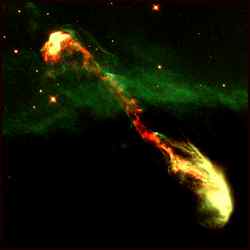
Stellar jets. Image credit: Hubble. Click to enlarge
Like traffic on a freeway, plasma spewing from the poles of newborn stars moves in clumps that travel at different speeds. When fast-moving particles run into slower material on these cosmic freeways, the resulting “traffic jams” create massive shock waves that travel trillions of miles.
Thanks to highly resolved images from the Hubble Space Telescope, a team of astronomers have created the first moving pictures of one of these cosmic freeways, which are known as stellar jets. The movies allow scientists to trace these stellar jet shock waves for the first time, gleaning important clues about a critical, yet poorly understood process of starbirth. The results appeared in the November issue of Astronomical Journal.
“When it comes to actually showing exactly what’s going on, there’s just nothing like a movie,” said study co-author Patrick Hartigan, associate professor of physics and astronomy at Rice University. “You can look at a still image and make up all kinds of stories, but they all go out the window when you see a movie.”
Hartigan and researchers from the Cerro Tololo Inter-American Observatory (CTIAO) in Chile, Arizona State University (ASU), the University of Hawaii and the University of Colorado at Boulder, made the movies using images taken in 1994 and 1999 of a newly formed star called HH 47 in the constellation Vela. Because Hubble flies above the Earth’s atmosphere, it can take much clearer images than Earth-based telescopes. As a result, Hartigan and his co-researchers were able to resolve objects in the Hubble images that were 20 times smaller than objects resolved in similar images taken on Earth. This extra resolution, and the five-year gap between Hubble surveys of HH 47, allowed them to make moving pictures of the stellar jet shock waves moving away from the new star.
“Imagine taking a photo at a football game that shows the quarterback throwing the ball at the start of a play,” Hartigan said. “There is no way to know what happened in the play without a second photograph at the end of the play that shows a touchdown, incomplete pass, interception, or whatever occurs. If you take a series of photos, with enough resolution to make out the ball, you could determine whether someone ran with the ball or caught a pass, and you could determine the relative position of all of the players to one another at any time during the play.
“Like the time-lapse images of the game, our movies give us the ability to track the movement of individual features within the stellar jet, both relative to stationary objects and relative to other objects that are moving within the jet at a different speed,” Hartigan said.
New stars form out of giant clouds of gas and dust. Within these clouds, strong gravitational forces pull material together into a tight ball surrounded by a large spinning disk. The new star forms out of the ball, and any planets that might form do so in the disk. Through processes not well-understood, much of the disk material gradually spirals into the star, and the resulting energy from this process drives stellar jets of plasma that erupt from the star at perpendicular angles to the spinning accretion disk. The material thrown away from the star in the jets acts as a brake on disk, slowing its rotation and allowing more material to fall into the growing star. Scientists know stellar jets play an integral role in star formation, but they have yet to determine the specifics of their role, or how it is carried out.
The research was funded by NASA. Co-authors on the study include CTIO’s Steve Heathcote, ASU’s Jon A. Morse, University of Hawaii’s Bo Reipurth and University of Colorado at Boulder’s John Bally.
Original Source: Rice University

Very nice NY Jets information. I hope to be in NYC for a game this fall.